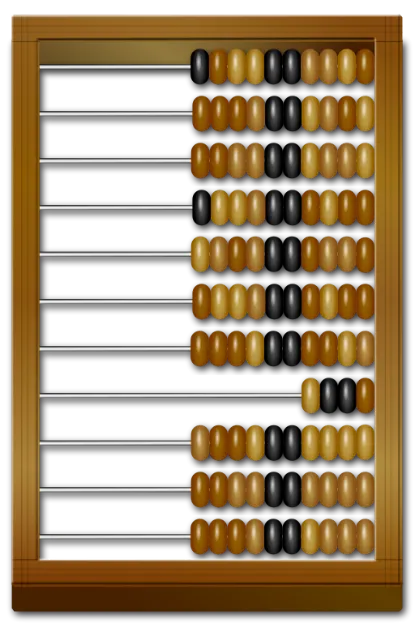In this video, we will discuss What is Abacus? who is the father of abacus? and Types of the abacus, so let’s discuss.
Table of Contents
What is Abacus?
- Abacus also referred to as a counting frame is the world’s first calculating device made by man, which is used to calculate or count by using sliding counters and a rod.
- Before the abacus, the only method people had to use to perform calculations were their fingers, toes, stones, or any various kinds of natural material.
- The name of abacus originated from the Latin word ‘abax’, which means ”tablet,” ”flat surface,” or ”board”.
- Abacus was widely in use in different countries from the Middle East to Japan, China, Russia as well as Europe.
- In ancient times, the abacus was widely used by merchants, business people, traders, etc. for their everyday operations.
- Originally it was invented to perform arithmetic calculations. But in today’s world, the abacus is used for different purposes. Today’s abacus is widely used in children’s brain development programs, which helps to increase their brain power.
What is the full form of abacus?
A – Abundant
B – Beads
A – Addition
C – Calculation
U – Utility
S – System
The full form of the Abacus is “Abundant Beads Addition Calculation Utility System“.
When was the abacus invented?
Actually, nobody knows the exact history of the abacus but it is believed that the abacus first appeared (or was invented) in Mesopotamia or Sumerian civilization between 2700bc – 2300bc. Sumerian (sumer) was the oldest civilization in human history founded in the Mesopotamia region (present-day part of Iraq, and part of Syria.)
It is the belief that Old Babylonian scholars used this abacus to do addition and subtraction. Babylonia was an ancient state based in central-southern Mesopotamia.
Some Historians also believed that the abacus was first invented in ancient china sometime during the Ming dynasty by mathematician Cheng Dawei.
Who is the father of the abacus?
Tim Cranmer is the father of the abacus because he invented an abacus that helps visually impaired people use it for calculations. Cranmer was also blind from childhood. This abacus was invented in 1962. His abacus called “Cranmer abacus” is still manufactured today and visually impaired people still use it for calculations.
Other names of Abacus
Suanpan (China): In China, it is called Suanpan.
Soroban (Japan): In Japan, It is called Soroban.
Jupan, Supan Or Jusan (Korea): In Korea, it is called Jupan, Supan, or Jusan.
Schoty (Soviet Russia): In Soviet Russia, it is called Schoty.
Types of abacus
There are many different types of abacus used like in China, abacus is used in a 2:5 ratio, or in japan, abacus is used in 1:4 ratio.
Chinese Abacus
- In China, Abacus is called ‘Suanpan‘.
- This type of abacus is often known as a 2/5 type abacus.
- Suanpan has 2 beads on the upper deck and 5 beads on the lower deck.
- This abacus is typically 8 inches (20 cm) long and comes in various widths.
- This abacus was based on the base16 number system.
- The beads are moved up and down for counting and calculations.
- The beads and the frame of this Chinese abacus (name Suanpan) are basically made up of hardwood or plastic.
- According to Wikipedia, first time the prototype of the Chinese abacus appeared during the Han dynasty at that time beads were oval.
- In the early Ming dynasty, the Suanpan (Chinese abacus) began to appear in a 1:5 ratio means 1 bead on the upper deck and 5 beads on the lower deck.
- But in the late Ming Dynasty, the abacus was changed to 2:5 ratio means 2 beads on the upper deck and 5 beads on the lower deck.

Japanese Abacus
- The Japanese abacus is called ‘Soroban’.
- Japanese abacus (Soroban) was derived from the Chinese abacus (Suanpan) brought to japan in the 14th century.
- Today’s Soroban is 1:4 ratio means 1 bead in the upper deck and 4 beads in the lower deck.
- This 1:4 type abacus, appeared in 1930 CE and get widespread all over japan.
- From then many efficient soroban techniques have been developed to do a variety of mathematical operations at very high speed.
- Soroban is still used in japan to teach kids in primary schools as part of mathematics.

Russian Abacus
- The Russian abacus is called ‘Schoty’
- Usually, it has a single-slanted deck with 10 beads on each wire.
- Schoty is more often used vertically with each wire running horizontally.
- The beads of this abacus are moved either left-to-right or right-to-left.
- The Russian abacus was pretty commonly used in shops and markets throughout Russia and its usage was being taught in primary schools in Russia until the 1990s.
- But after the invention of the calculator, the use of schoty has declined very drastically.
